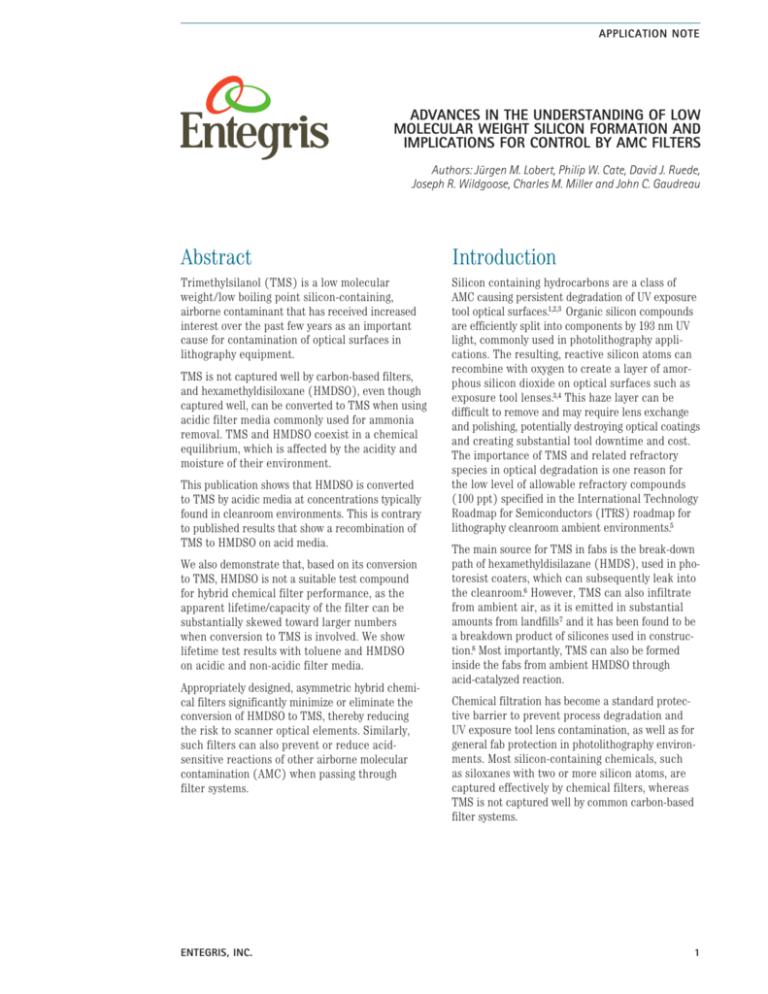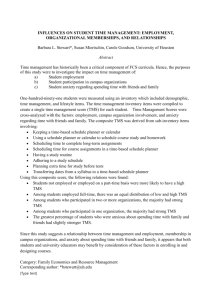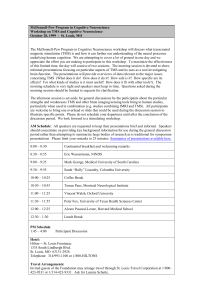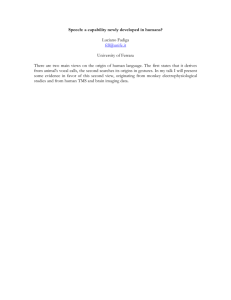
APPLICATION NOTE
ADVANCES IN THE UNDERSTANDING OF LOW
MOLECULAR WEIGHT SILICON FORMATION AND
IMPLICATIONS FOR CONTROL BY AMC FILTERS
Authors: Jürgen M. Lobert, Philip W. Cate, David J. Ruede,
Joseph R. Wildgoose, Charles M. Miller and John C. Gaudreau
Abstract
Introduction
Trimethylsilanol (TMS) is a low molecular
weight / low boiling point silicon-containing,
airborne contaminant that has received increased
interest over the past few years as an important
cause for contamination of optical surfaces in
lithography equipment.
Silicon containing hydrocarbons are a class of
AMC causing persistent degradation of UV exposure
tool optical surfaces.1,2,3 Organic silicon compounds
are efficiently split into components by 193 nm UV
light, commonly used in photolithography applications. The resulting, reactive silicon atoms can
recombine with oxygen to create a layer of amorphous silicon dioxide on optical surfaces such as
exposure tool lenses.3,4 This haze layer can be
difficult to remove and may require lens exchange
and polishing, potentially destroying optical coatings
and creating substantial tool downtime and cost.
The importance of TMS and related refractory
species in optical degradation is one reason for
the low level of allowable refractory compounds
(100 ppt) specified in the International Technology
Roadmap for Semiconductors (ITRS) roadmap for
lithography cleanroom ambient environments.5
TMS is not captured well by carbon-based filters,
and hexamethyldisiloxane (HMDSO), even though
captured well, can be converted to TMS when using
acidic filter media commonly used for ammonia
removal. TMS and HMDSO coexist in a chemical
equilibrium, which is affected by the acidity and
moisture of their environment.
This publication shows that HMDSO is converted
to TMS by acidic media at concentrations typically
found in cleanroom environments. This is contrary
to published results that show a recombination of
TMS to HMDSO on acid media.
We also demonstrate that, based on its conversion
to TMS, HMDSO is not a suitable test compound
for hybrid chemical filter performance, as the
apparent lifetime/capacity of the filter can be
substantially skewed toward larger numbers
when conversion to TMS is involved. We show
lifetime test results with toluene and HMDSO
on acidic and non-acidic filter media.
Appropriately designed, asymmetric hybrid chemical filters significantly minimize or eliminate the
conversion of HMDSO to TMS, thereby reducing
the risk to scanner optical elements. Similarly,
such filters can also prevent or reduce acidsensitive reactions of other airborne molecular
contamination (AMC) when passing through
filter systems.
ENTEGRIS, INC.
The main source for TMS in fabs is the break-down
path of hexamethyldisilazane (HMDS), used in photoresist coaters, which can subsequently leak into
the cleanroom.6 However, TMS can also infiltrate
from ambient air, as it is emitted in substantial
amounts from landfills 7 and it has been found to be
a breakdown product of silicones used in construction.8 Most importantly, TMS can also be formed
inside the fabs from ambient HMDSO through
acid-catalyzed reaction.
Chemical filtration has become a standard protective barrier to prevent process degradation and
UV exposure tool lens contamination, as well as for
general fab protection in photolithography environments. Most silicon-containing chemicals, such
as siloxanes with two or more silicon atoms, are
captured effectively by chemical filters, whereas
TMS is not captured well by common carbon-based
filter systems.
1
ADVANCES IN THE UNDERSTANDING OF LOW MOLECULAR WEIGHT SILICON FORMATION AND IMPLICATIONS FOR CONTROL BY AMC FILTERS
Common hybrid filtration systems used in photolithography optics protection use a mix of acidic,
basic and/or neutral AMC adsorption media.
In most cases, the mix is uniform in distribution
throughout the filter systems or in some cases, acid
layers are upstream, exacerbating the conversion of
HMDSO to TMS. Filter lifetime performance evaluation becomes ambiguous if AMC test agents undergo
reactions while passing through filter media.
Experimental Approach
For the measurement of TMS and HMDSO at high
concentrations, we employed a quasi-continuous
monitoring system comprised of a gas chromatograph with flame ionization detector (GC-FID),
cryogenic pre-concentration and a continuous inlet
system. A dynamic dilution calibration system is also
used for calibration and can employ liquid diffusion
and injection sources of pure TMS and HMDSO, as
well as a reactive source for TMS. For low concentration measurements in the parts per trillion range
(ppt, 10-12), we employed the method described
by Lobert et al.9, which uses carbon-based trap
samples followed by solvent extraction and GC-mass
spectrometry analysis. Online gas chromatograph
systems with photo-ionization detector (GC-PID)
are used for the quasi-continuous monitoring
of toluene.
For filter performance studies and product development, Entegris uses a versatile wind tunnel facility
for the testing of full- and sub-size filters at various
flow rates and with controlled temperature and
humidity (Figure 1). This facility is capable of testing sub- and full-size filters at nominal flow rates,
i.e., under real-world conditions. Temperature and
humidity are maintained at levels typical for photolithography environments (22°C and 40%). Injection
systems for liquid and gas-phase contaminants allow
for variable concentrations of test contaminants
between 10 parts per billion (ppb, 10 - 9) and 10 parts
per million (ppm, 10 - 6). The most common test
concentration is 1 ppm (1000 ppb) for accelerated
lifetime tests and 30 ppb for low concentration
challenges. Accelerated lifetime tests typically
take between several days and four weeks.
The test facility also allows for testing filter stacks
of up to five filters to accommodate filter sets
as used in filter systems for the protection of
exposure tools.
2
AMC monitoring
and sampling
Chemical filter
zero air supply
Test filter 1
Liquid
challenge
Test filter 1
Test filter 2
Test filter 2
Test filter 3
Test filter 3
Test filter 4
1 00
%
0
0 .0 1
2 .0 1
4 .0 1
6 .0 1
8 .0 1
1 0 .0 1
1 2 .0 1
1 4 .0 1
1 6 .0 1
1 8 .0 1
2 0 .0 1
2 2 .0 1
T im e
2 4 .0 1
AMC monitoring
and sampling
Exhaust
Figure 1. Portion of the wind tunnel facility and schematic of
operation used to study chemical filter performance.
Liquid TMS and HMDSO with 99% purity were used
for the calibrations in this study. Air streams used
for the dilution and filter tests were purified using
Entegris chemical filter systems such that AMC
backgrounds were insignificant compared to
challenge concentrations studied.
Equilibrium and Conversion
of HMDSO to TMS
HMDSO and TMS (Figure 2) exist in an equilibrium
state,10 which is governed by the presence of moisture (Eq. 1).
HMDSO + 2H2 O
2TMS
Eq. 1
This equilibrium favors formation of TMS either in
aqueous solution or with significant air moisture
(40% RH). However, formation of TMS can be
diminished by filtering out the HMDSO present
in air (e.g., through recirculation and advanced
chemical filters), which shifts the equilibrium to
favor formation of HMDSO from TMS.
APPLICATION NOTE
ENTEGRIS, INC.
ADVANCES IN THE UNDERSTANDING OF LOW MOLECULAR WEIGHT SILICON FORMATION AND IMPLICATIONS FOR CONTROL BY AMC FILTERS
400
Figure
and toluene,
TMS2. Molecular structure
HMDSOof TMS, HMDSO
Toluene
filter test agents used for this study.
The initiation of the HMDSO breakdown in Eq. 1
also takes place in hybrid chemical filter media
containing acidic layers or acid-coated carbon,
and forms TMS, which is a low boiling point / low
molecular weight AMC that propagates through a
chemical filter array much faster than HMDSO.4
The acid-catalyzed reaction appears to be much
more efficient than the natural equilibrium.
Observations on high concentration (~25 ppm)
systems found that the acid-catalyzed equilibrium
favors the condensation of two molecules of TMS
into one molecule of HMDSO when encountering
acidic filter media.11 However, such high concentrations cannot be found in lithography environments,
where typical TMS concentrations are much less
than 100 ppb, and those of HMDSO a factor 10
less than TMS.9
Tests in the Entegris wind tunnel facility clearly
showed that the conversion of HMDSO to TMS on
acidic media is consistent at low concentrations
(less than 1 ppm). The near-quantitative conversion of HMDSO on acidic beds is actually used in
our labs to create TMS challenge gases4 that are
employed for filter and media testing. The equilibrium concentrations of TMS and HMDSO on an
acid bed were experimentally determined and are
summarized in Figure 3. A source concentration of
180 ppb HMDSO, for example, yielded only 65 ppb
HMDSO downstream of the acid chemical filter
(green curve), whereas most of it (115 ppb) is
converted to yield 230 ppb TMS. The HMDSO yield,
however, increases at higher concentrations and it
is conceivable that it is favored at very high TMS
concentrations (>>1 ppm).
ENTEGRIS, INC
TMS yield
HMDSO yield
TMS Fit
HMDSO fit
Si OH Si
Yield Concentration (ppb)
Si OH
300
200
100
0
0
100
200
300
HMDSO Source Concentration (ppb)
Figure 3. The yield of HMDSO and TMS when converting
HMDSO on acidic media at concentrations below 1 ppm.
TMS yield downstream is always higher than HMDSO yield.
TMS was always a product of HMDSO conversion
and TMS concentrations were always higher
than those of HMDSO. The condensation of two
molecules of TMS into one molecule of HMDSO
was not observed to be dominant at concentrations below 1 ppm.
Using the above experimental data to calculate
that reverse reaction, how much TMS could
be condensed into HMDSO below 1 ppm, yields
HMDSO values of only 3 – 20% of TMS on the
same acid media. Whereas this condensation
may happen at the same time as our observed
HMDSO breakdown, the resulting net conversion
is that of HMDSO to TMS.
For the natural, uncatalyzed equilibrium, we calculate even lower yields for the formation of HMDSO
from TMS. Concentrations up to 10 ppm of TMS
should yield only 10 ppb of HMDSO and TMS at
cleanroom levels of 1 ppb would not produce any
significant amounts of HMDSO.
APPLICATION NOTE 3
ADVANCES IN THE UNDERSTANDING OF LOW MOLECULAR WEIGHT SILICON FORMATION AND IMPLICATIONS FOR CONTROL BY AMC FILTERS
Filter Testing with Toluene
and HMDSO
Advantages of Toluene as a Test Agent
The described conversion of HMDSO to TMS on
acidic filter media poses a problem when performance testing of chemical filters is carried out
with HMDSO instead of other, more inert compounds. Entegris promotes the use of toluene (C6H7,
Figure 2) as a filter test agent because it is inexpensive, it is at the low end of the organics range that is
targeted with chemical filter systems for exposure
tools and, hence, represents a worst-case filter performance scenario, very similar to HMDSO. Toluene
is also a common reference compound recognized
by the ITRS and some OEMs and is the most
common calibration compound for organic AMC
detection. More importantly, it is non-reactive in
most environmental settings relevant to photolithography and it does not adhere (“stick”) to
surfaces of the test facility. Toluene is purged out
of the wind tunnel system with clean air quickly
and it does not cloud optical, analytical detection
systems such as photo-ionization detectors.
Typical lifetime performance curves for toluene
removal on a chemical filter system consisting of
three hybrid media (acid / activated carbon) filters
is shown in Figure 4. Toluene retains its integrity
upstream and downstream of the filter set over
long periods of time.
Removal Efficiency (%)
100
Filter 3
outlet
95
Filter 2
outlet
Filter 1
outlet
90
0
200
400
600
800 1000
Filter Lifetime (ppb-h)
1200
1400
Figure 4. Smoothed toluene performance curves on a set of
three carbon-containing AMC filters.
4
Results from Using HMDSO as a Test Agent
Whereas toluene provides chemically conservative
performance curves, HMDSO does not. Figure 5
shows the results of using HMDSO as a test agent
when using acidic hybrid filter media. Entegris
filtration systems for optics protection contains
three filters in series (Figure 6a), creating two
“interstacks” between filters 1 and 2, as well as
between filters 2 and 3. “Inlet” is the upstream
challenge before filter 1, “outlet” is the concentration downstream of the entire filter stack.
Panel (a) in Figure 5 shows the upstream HMDSO
challenge concentration, which was maintained
around 825 ppb. Upstream TMS concentration,
mostly an impurity of the HMDSO used to create
the challenge, was below 0.1 ppb, insignificant for
the test purpose.
Panels (b) through (d) in Figure 5 show the TMS
and HMDSO concentrations after filters 1, 2 and 3.
Even though the upstream TMS challenge was zero,
very high amounts of TMS were observed downstream of all chemical filters.
Filter #1
For the 825 ppb inlet challenge, which is equivalent
to 1650 ppb of TMS, about 548 ±59 ppb of TMS is
produced from conversion on the first hybrid filter
(brown triangles in Figure 5b), a portion of 33% of
the available silicon. Together with the unchanged
HMDSO breaking through (blue squares), the
upstream challenge concentration of silicon is
reached after filter 1 at about 700 hours into the
test (this is the steady-state point, where upstream
and downstream concentrations are the same
because of breakthrough).
Filter #2
The second filter outlet builds up TMS (red triangles in Figure 5c), and levels off at 684 ±84 ppb.
Assuming that the HMDSO concentration of the
first interstack at 548 ±59 ppb is the challenge to
the second filter, and assuming furthermore that
all of the produced TMS eventually passes through
these filters largely unchanged, we can conclude
that the second interstack adds at least another
157 ppb from conversion of first interstack HMDSO.
That conversion would be 14% of the available
HMDSO. Summing TMS and HMDSO (light blue
squares) together, the upstream challenge concentration of silicon (about 825 ppb) is reached after
filter 2 at about 1000 hours into the test.
APPLICATION NOTE
ENTEGRIS, INC.
ADVANCES IN THE UNDERSTANDING OF LOW MOLECULAR WEIGHT SILICON FORMATION AND IMPLICATIONS FOR CONTROL BY AMC FILTERS
Filter #3
Steady-state TMS Concentration
Outlet data of the third filter showed 694 ±105 ppb
TMS (orange triangles in Figure 5d), which had not
leveled off yet and would have probably settled in
around 800 ppb (extrapolated). HMDSO showed
330 ppb, which still significantly increased and had
not yet leveled off at the end of the test. Outlet TMS
would be a combination of TMS in the second interstack plus any new conversion, which is based on
the ~500 ppb of HMDSO in the second interstack.
That conversion is numerically only 1%, because
concentrations were not fully leveled yet.
TMS concentrations leveled off at about 550 ppb,
680 ppb and 800 ppb (estimated). The leveling off
of TMS concentration after each filter is mostly a
function of conversion efficiency on the acid filter
media. That means that the conversion reaches a
steady-state, governed by the HMDSO challenge
concentration as well as the availability of conversion sites (media density, granular structure and
acid strength), flow rate, humidity and temperature.
With flow, RH, temperature and available sites
being constant in any one filter design, conversion
of HMDSO to TMS diminishes from filter to filter,
mostly based on HMDSO concentration. However,
the cumulative amount of TMS at the outlet of the
filter stack (800 ppb) equals a conversion of about
50% of the available silicon challenge (1650 ppb)
once all filters are saturated.
HMDSO Concentration (ppb)
In addition, as mentioned previously in Figure 3,
a portion of the TMS may have been converted back
to HMDSO, numerically diminishing the TMS yield
somewhat. The sum of TMS and HMDSO after filter
3 did not yet reach the original challenge concentration, confirming that the filter was not saturated
yet. That steady-state would have been reached
around 1200 hours into the test (extrapolated data).
1000
800
600
Upstream Challenge
TMS = 0
400
0
0
Concentrations (ppb)
200
400
600
800
1000
Interstack 1
800
Filter 1
TMS
600
(b)
400
200
0
Concentrations (ppb)
(a)
200
1000
HMDSO
0
1000
200
400
Interstack 2
800
600
800
1000
TMS
Filter 2
600
(c)
400
200
0
Concentrations (ppb)
HMDSO
HMDSO
0
1000
200
400
600
800
1000
Downstream
800
Filter 3
600
(d)
TMS
400
HMDSO
200
0
0
200
400
600
800
1000
Figure 5. TMS production from HMDSO on acidic media.
ENTEGRIS, INC
APPLICATION NOTE 5
ADVANCES IN THE UNDERSTANDING OF LOW MOLECULAR WEIGHT SILICON FORMATION AND IMPLICATIONS FOR CONTROL BY AMC FILTERS
Impact on Filter Performance Estimates
The conversion of HMDSO to TMS theoretically
should increase the lifetime estimate for HMDSO
on the filter system, because the filter is challenged
with less HMDSO and the TMS yield is not counted
toward the lifetime. We found, however, that the
resulting lifetime estimate for HMDSO was very
similar to that of a parallel test with toluene as the
challenge gas. This outcome, in effect, means that
HMDSO is not as efficiently retained by the chemical filter media as expected, presumable because
of the presence of TMS, which occupies the same
active sites on the carbon media.
Solutions to Prevent the
Conversion of HMDSO to
TMS on Chemical Filters
Figure 6a shows the filter design as used for the
test in the prior section. Figure 6b shows a common
filter design that uses the acid media upstream
of the filter and which exacerbates the catalytic
decomposition of HMDSO. That conversion of
HMDSO to TMS can easily be prevented by employing an asymmetric filter design (AFD) as shown
in Figure 6c. The asymmetric design 2 employs
non-acidic carbon media in its first two of three
Note that TMS already present in air would migrate
through any of the filter systems in similar fashion,
regardless of the design of the filter system. Capture
and retention of TMS in air (below 1 ppm) is only
governed by the absolute amount of adsorptive
media as well as the flow rate and TMS concentration, but not by the acid layer sequence.
HMDSO is not the only compound of interest that
reacts on acidic media. Propylene Glycol Methyl
Ether Acetate (PGMEA) is a common solvent used
in photoresist applications and one of the most
abundant organic chemicals found in lithography
environments. PGMEA reacts on acidic surfaces
to form, amongst others, acetic acid. Acetic acid
is an undesired AMC and subject to acid control
requirements by exposure tool OEMs. Preventing
the formation of acetic acid is another benefit
of the asymmetric filter design introduced here
(patents pending).
Uniform/Symmetric Design (a)
Asymmetric Design 1 (b)
Acidic Media
Activated Carbon / Base Carbon
Activated Carbon / Base Carbon
HMDSO capture;
no conversion
Activated Carbon / Base Carbon
Activated Carbon / Base Carbon
Acidic Media
Acid conversion
of HMDSO
Acidic Media
Activated Carbon / Base Carbon
Acidic Media
Activated Carbon / Base Carbon
Acidic Media
Activated Carbon / Base Carbon
Acid conversion
of HMDSO
filters (or filter layers) and adds the acidic media
to the end. This design still provides the necessary
retention of ammonia and bases on its last filter,
but prevents the conversion of HMDSO to TMS
on its first or first two filters, as is the case in the
uniform design and asymmetric design 1. This
new asymmetric filter design 2 has been developed
by Entegris for the use in tool filter systems for
optics protection.
Asymmetric Design 2 (c)
Flow Direction
Figure 6. Schematic of (a) uniform mixed media, (b) an asymmetric design that causes the same conversions
and (c) an asymmetric filter design which prevents acid conversions of organic compounds.
6
APPLICATION NOTE
ENTEGRIS, INC.
Conclusions
We described the equilibrium conversion of
HMDSO and TMS, particularly when encountering
acidic chemical filter media.
A state-of-the-art wind tunnel test facility with
the ability to vary AMC concentrations between
very low and very high levels is required to fully
understand dynamic chemical interactions between
AMC challenges. Advanced analytical capabilities
are required to measure all AMC with confidence
at all concentrations.
We showed that HMDSO is converted to TMS on
acidic surfaces at concentrations below 1000 ppb.
The inverse reaction, condensation of TMS to
HMDSO, does not contribute much at these
concentration levels.
We clearly showed that HMDSO is an unsuitable
chemical for testing chemical filter system lifetime performance. HMDSO is reactive and requires
interpretation of results. Toluene is a test agent
that behaves conservatively and yields unambiguous results.
Avoiding contact of captured HMDSO with acidic
media is suggested when designing chemical filter
systems for optics protection in photolithography.
The design of an asymmetric filter system with
acidic media last in sequence was introduced for
the use in optics protection applications.
References
1.Matsumoto, Y. and Miyaji, A., U.S. Patent
5,430,303 Exposure Apparatus; July 4, 1995.
2.Fosshaug, H., Ekberg, M. and Kylberg, G.,
“Some aspects on mechanism responsible for
contamination of optical components in DUV
lithographic exposure tool,” Proc SPIE, v. 5754,
p. 1601-1628, (2005).
3.Kuntz, R.R., Liberman, V., Downs, D.,
“Experimentation and modeling of organic
photocontamination on lithographic optics,”
J. Vac. Sci. Technol., B 18, 1306-1313, 2000.
4.Grayfer, A., Belanger, F., Cate, P., Ruede, D.,
“New filter media development for effective
control of trimethylsilanol (TMS) and related low molecular weight silicon containing
organic species in the photobay ambient,” Proc.
SPIE, 6518, 651842-1 (2007).
5.The International Technology Roadmap for
Semiconductors, ITRS 2009. www.itrs.net
6.Belanger, F., Cate, P., Grayfer, A., Petersen, R.,
Ruede, D., “Examination of the prevalence and
abundance of noncondensable, nonreactive
optical surface contaminants in the scanner
environment,” Proc. SPIE, 5754-200 (2005).
7.Grümping, R., Mikolajczak, D., Hirner, A.V.,
“Determination of trimethylsilanol in the
environment by LT-GC/ICP-OES and GC-MS,”
Fresenius J Anal Chem, 361, 133-139 (1998).
8.Coleman, M. 1991. Summary Report of
Postflight Atmospheric Analysis for STS-26 to
STS-36, SD4-91-430, National Aeronautics and
Space Administration, Washington, D.C.
9.Lobert, J.M., Miller, C.M., Grayfer, A., Tivin,
A.M., “Measurement of low molecular weight
silicon AMC to protect UV optics in photolithography environments,” Metrology, Inspection,
and Process Control for Microlithography
XXIII, edited by John A. Allgair, Christopher J.
Raymond, Proceedings of SPIE Vol. 7272 (SPIE,
Bellingham, WA 2009) 727222.
10.Protasova, L.V., Grinberg, E.E., Bessarabov, A.M.,
Makarov, V.V., Polyanskii, M.A., “The mechanism
and kinetics of the synthesis of hexamethyldisiloxane,” Russian journal of physical
chemistry, 65 (2), 283-28 (1991).
11.Seguin K., Dallas, A., Weineck, G.,
“Semiconductor Filtration Technical Note
CFTN-1-SC,” Donaldson, February (2008).
This application note is a technical publication:
Lobert, J.M., Cate, P.W., Miller, C.M., Ruede, D.J.,
Wildgoose, J.R., “Considerations for chemical filter
performance for low molecular weight silicon AMC.”
Proc. SPIE, 7638, 7638110, 2010.
Entegris®, the Entegris Rings Design® and Creating a Material Advantage® are registered trademarks of Entegris, Inc.
ENTEGRIS, INC.
Corporate Headquarters | 129 Concord Road | Billerica, MA 01821 USA
Customer Service Tel. +1 952 556 4181 | Customer Service Fax +1 952 556 8022
In North America 800 394 4083 | www.entegris.com
©2014 Entegris, Inc.
All rights reserved
Printed in USA
1847-7587ENT-0914









